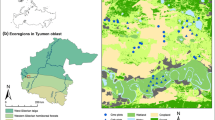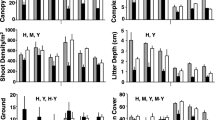Abstract
How flooding regimes shape temperate-zone butterfly communities has received little attention. At the river Danube in eastern Austria, a levee has largely interrupted natural river dynamics since the late nineteenth century. Only a fraction of the floodplain area still experiences annual summer inundations after snow-melt in the Alps. We surveyed meadow butterfly communities on either side of the levee in a year with an unusually strong flood (2013), and in a season with a weak flood typical for the region (2012). Altogether we observed 67 butterfly species. Butterfly abundance and species richness were lower on meadows with stronger flood impact, but differences were modest. In contrast, species composition differed prominently relative to flooding regime and nectar availability. Grass-feeding species tended to be rarer on flooded meadows, while Brassicaceae-feeding species were more prevalent on nutrient-rich flood-prone meadows. Highly dispersive butterflies made up a larger share on flooded meadows, whereas highly philopatric species were relatively more common at sites with little or no inundation. These results indicate that summer inundations at the river Danube act as filters for the local species composition of butterflies on floodplain meadows. Local resource availability and the differential potential of species to re-colonize meadows after catastrophic floods are likely drivers of these differences. Effects of inundations were not consistently stronger in a year of a catastrophic flood than in a normal season. Butterfly communities on non-flooded meadows had a higher regional conservation value.





Similar content being viewed by others
References
Adis J, Junk WJ (2002) Terrestrial invertebrates inhabiting lowland river floodplains of Central Amazonia and Central Europe: a review. Freshwater Biol 47:711–731. doi:10.1046/j.1365-2427.2002.00892.x
Anderson M, Gorley RN, Clarke RK (2008) Permanova+ for Primer: Guide to software and statistical methods. Primer-E, Plymouth
Ballinger A, Lake P, Nally RM (2007) Do terrestrial invertebrates experience floodplains as landscape mosaics? Immediate and longer-term effects of flooding on ant assemblages in a floodplain forest. Oecologia 152:227–238
Bink FA (1992) Ecologische atlas van de dagvlinders van Noordwest-Europa. Schuyt, Haarlem
Bonn A, Hagen K, Wohlgemuth-von Reiche D (2002) The significance of flood regimes for carabid beetle and spider communities in riparian habitats, a comparison of three major rivers in Germany. River Res Appl 18:43–64
Croxton PJ, Hann JP, Greatorex-Davies JN, Sparks TH (2005) Linear hotspots? The floral and butterfly diversity of green lanes. Biol Conserv 121:579–584
Demetz A, Fiedler K, Dreschke T, Schulze CH (2013) Natural floodplain dynamics shape grasshopper assemblages of meadows in the Donau-Auen National Park (Austria). 5th Symp Res Protected Areas, Mittersill, Austria
Dziock F, Gerisch M, Siegert M, Hering I, Scholz M, Ernst R (2011) Reproducing or dispersing? Using trait based habitat templet models to analyse Orthoptera response to flooding and land use. Agric Ecosyst Environ 145:85–94. doi:10.1016/j.agee.2011.07.015
Ebert G (1993) Die Schmetterlinge Baden-Württembergs, Band 1 Tagfalter 1. 1991 Eugen Ulmer, Stuttgart
Ellenberg H, Weber HE, Düll R, Wirth V, Werner W, Paulißen D (1992) Zeigerwerte von Pflanzen in Mitteleuropa, 2nd ed. Scr Geobot 18:9–166
Fiedler K, Truxa C (2012) Species richness measures fail in resolving diversity patterns of speciose forest moth assemblages. Biodiv Conserv 21:2499–2508. doi:10.1007/s10531-012-0311-5
Gerisch M, Schanowski A, Figura W, Gerken B, Dziock F, Henle K (2006) Carabid beetles (Coleoptera, Carabidae) as indicators of hydrological site conditions in floodplain grasslands. Int Rev Hydrobiol 91:326–340
Gotelli NJ, Colwell RK (2011) Estimating species richness. Biol Divers Front Meas Assess 12:39–54
Gratzer M, Rabitsch W, Schulze CH (2012) Impact of flooding on true bug communities (Heteroptera) on meadows of the Morava River floodplains, Eastern Austria. 5th Symp Res Proteced Areas, Mittersill, Austria
Holl KD (1995) Nectar resources and their influence on butterfly communities on reclaimed coal surface mines. Restor Ecol 3:76–85
Höttinger H, Pendl M, Wiemers M, Pospisil A (2013) Insekten in Wien: Tagfalter. Österr Ges Entomofaunistik, Vienna
Huemer P (2013) Die Schmetterlinge Österreichs (Lepidoptera). Systematische und faunistische Checkliste. Tiroler Landesmuseen, Innsbruck
Hula V, Konvicka M, Pavlicko A, Fric Z (2004) Marsh Fritillary (Euphydiyas aurinia) in the Czech Republic: monitoring, metapopulation structure and conservation of an endangered butterfly. Entomol Fenn 15(4):231–241
Joy J, Pullin AS (1997) The effects of flooding on the survival and behaviour of overwintering large heath butterfly Coenonympha tullia larvae. Biol Conserv 82:61–66. doi:10.1016/s0006-3207(97)00006-2
Kajzer-Bonk J, Nowicki P, Bonk M, Skórka P, Witek M, Woyciechowski M (2013) Local populations of endangered Maculinea (Phengaris) butterflies are flood resistant. J Insect Conserv 17:1105–1112. doi:10.1007/s10841-013-9591-7
Koh LP, Sodhi NS, Brook BW (2004) Ecological correlates of extinction proneness in tropical butterflies. Conserv Biol 18:1571–1578
Konvicka M, Nedved O, Fric Z (2002) Early-spring floods decrease the survival of hibernating larvae of a wetland-inhabiting population of Neptis rivularis (Lepidoptera: Nymphalidae). Acta Zool Hung 48:79–88
Köppel C (1997) Die Großschmetterlinge (Makrolepidoptera) der Rastatter Rheinaue: Habitatwahl sowie Überflutungstoleranz und Überlebensstrategien bei Hochwasser. Eitschberger, Markleuthen
Krauss J, Steffan-Dewenter I, Tscharntke T (2004) Landscape occupancy and local population size depends on host plant distribution in the butterfly Cupido minimus. Biol Conserv 120:355–361
Krauss J, Steffan-Dewenter I, Müller CB, Tscharntke T (2005) Relative importance of resource quantity, isolation and habitat quality for landscape distribution of a monophagous butterfly. Ecography 28:465–474
Latterell JJ, Scott Bechtold J, O’Keefe TC, Van Pelt R, Naiman RJ (2006) Dynamic patch mosaics and channel movement in an unconfined river valley of the Olympic Mountains. Freshwater Biol 51:523–544. doi:10.1111/j.1365-2427.2006.01513.x
León-Cortés JL, Lennon JJ, Thomas CD (2003) Ecological dynamics of extinct species in empty habitat networks. 2. The role of host plant dynamics. Oikos 102:465–477
Maes D, Van Dyck H (2001) Butterfly diversity loss in Flanders (north Belgium): Europe’s worst case scenario? Biol Conserv 99:263–276
Mucina L, Grabherr G, Ellmauer T, Wallnoefer S (1993) Die Pflanzengesellschaften Österreichs. Fischer, Jena
Pike N (2011) Using false discovery rates for multiple comparisons in ecology and evolution. Meth Ecol Evol 2:278–282
Reiss J, Bridle JR, Montoya JM, Woodward G (2009) Emerging horizons in biodiversity and ecosystem functioning research. Trends Ecol Evol 24:505–514. doi:10.1016/j.tree.2009.03.018
Rothenbuecher J, Schaefer M (2005) Conservation of leafhoppers in floodplain grasslands—trade-off between diversity and naturalness in a northern German national park. J Insect Conserv 9:335–349. doi:10.1007/s10841-005-0514-0
Saarinen K, Valtonen A, Jantunen J, Saarnio S (2005) Butterflies and diurnal moths along road verges: does road type affect diversity and abundance? Biol Conserv 123:403–412
Schultz CB, Dlugosch KM (1999) Nectar and hostplant scarcity limit populations of an endangered Oregon butterfly. Oecologia 119:231–238
Severns PM, Boldt L, Villegas S (2006) Conserving a wetland butterfly: quantifying early lifestage survival through seasonal flooding, adult nectar, and habitat preference. J Insect Conserv 10:361–370. doi:10.1007/s10841-006-9011-3
Shahabuddin G, Herzner GA, Aponte CR, del Gomez MC (2000) Persistence of a frugivorous butterfly species in Venezuelan forest fragments: the role of movement and habitat quality. Biodivers Conserv 9:1623–1641
Shapiro AM (2002) The Californian urban butterfly fauna is dependent on alien plants. Divers Distrib 8:31–40
Sonntag G (1981) Öko-ethologische Untersuchungen zur Sexualbiologie des Schachbrettfalters (Agapetes galathea L.) unter besonderer Berücksichtigung thermobiologischer Aspekte. Z Tierpsychol 56:169–186
Stettmer C, Bräu M, Gros P, Wanninger O (2011) Die Tagfalter Bayerns und Österreichs. 2nd edn. Bayerische Akademie für Naturschutz und Landschaftspflege, Laufen
Strausz M, Fiedler K, Franzén M, Wiemers M (2012) Habitat and host plant use of the Large Copper Butterfly Lycaena dispar in an urban environment. J Insect Conserv 16:709–721
Thomas JA (1983) The ecology and conservation of Lysandra bellargus (Lepidoptera: Lycaenidae) in Britain. J Appl Ecol 20:59–83
Thomas CD, Jones TM (1993) Partial recovery of a skipper butterfly (Hesperia comma) from population refuges: lessons for conservation in a fragmented landscape. J Anim Ecol 62:472–481
Thomas J et al (2001) The quality and isolation of habitat patches both determine where butterflies persist in fragmented landscapes. Proc R Soc London B 268:1791–1796
Tockner K, Schiemer F, Ward JV (1998) Conservation by restoration: the management concept for a river-floodplain system on the Danube River in Austria. Aquat Conserv Mar Freshwater Ecosyst 8:71–86
Tropek R, Konvicka M (2010) Forest eternal? Endemic butterflies of the Bamenda highlands, Cameroon, avoid close-canopy forest. Afr J Ecol 48:428–437
Truxa C, Fiedler K (2012) Down in the flood? How moth communities are shaped in temperate floodplain forests. Insect Conserv Divers 5:389–397
Van Helsdingen PJ (1997) The spiders (Araneida) of Pollardstown Fen, Co Kildare, Ireland. Irish Nat J 25:396–404
Wahlberg N, Klemetti T, Hanski I (2002) Dynamic populations in a dynamic landscape: the metapopulation structure of the marsh fritillary butterfly. Ecography 25:224–232
Webb MR, Pullin AS (1998) Effects of submergence by winter floods on diapausing caterpillars of a wetland butterfly, Lycaena dispar batavus. Ecol Entomol 23:96–99. doi:10.1046/j.1365-2311.1998.00105.x
Wiklund C (1984) Egg-laying patterns in butterflies in relation to their phenology and the visual apparency and abundance of their host plants. Oecologia 63:23–29
Acknowledgments
We thank the Nationalpark Donau-Auen, and especially Dr. Christian Baumgartner and Karoline Zsak, for arranging the opportunity to conduct this study and Barabara Reischl for her support with the illustrations. Manuela Grijincu and Hannes Horn helped with data collection in 2012. This paper benefitted from constructive comments provided by two anonymous reviewers. Field work was supported through funds from the Faculty of Life Sciences, Univ. of Vienna.
Author information
Authors and Affiliations
Corresponding author
Electronic supplementary material
Below is the link to the electronic supplementary material.
Rights and permissions
About this article
Cite this article
Fies, R., Rabl, D., Schulze, C.H. et al. Summer floods shape meadow butterfly communities in a floodplain nature reserve in Central Europe. J Insect Conserv 20, 433–445 (2016). https://doi.org/10.1007/s10841-016-9876-8
Received:
Accepted:
Published:
Issue Date:
DOI: https://doi.org/10.1007/s10841-016-9876-8




